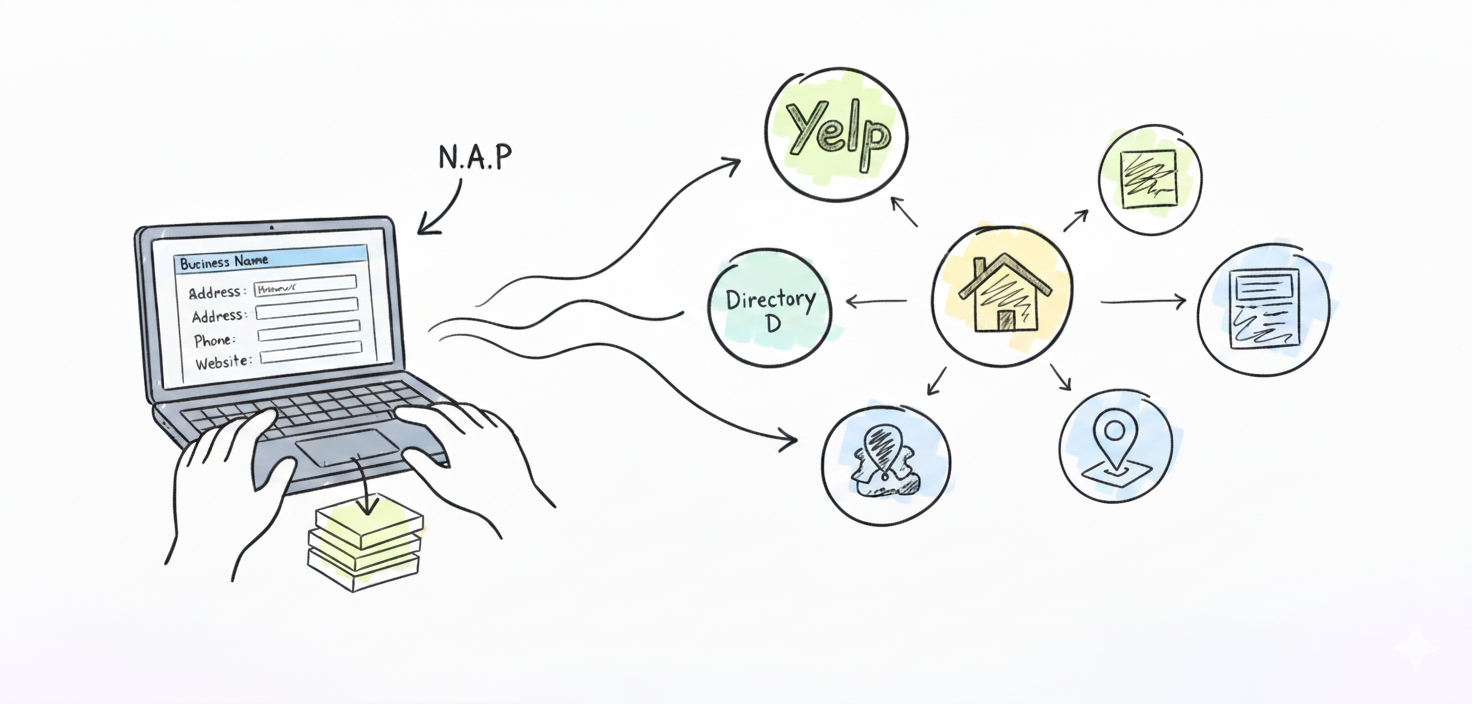AI Search & SEO for Local Business
Entity Mapping for Local Businesses: How to Boost Google Rankings in 2025
After working with local service businesses for years, I’ve seen one clear pattern: the companies ranking on page one all have a strong, well-built Google entity graph - and most competitors haven’t even begun

Understanding How Google Processes Local Business Entities
Google's search algorithm has evolved significantly beyond simple keyword matching. Modern search works by identifying and connecting real-world entities — people, places, organizations, and concepts that Google's Knowledge Graph already recognizes and understands.
According to Google's own Search Quality Rater Guidelines, the search engine evaluates the expertise, authoritativeness, and trustworthiness of content and the entities behind it. This framework directly influences how local businesses are ranked.
When someone searches for "roofing contractor in Jupiter FL," Google isn't just matching keywords. It's trying to determine which business entity has the strongest, most verifiable connection to:
- The geographic entity "Jupiter, Florida"
- The service entity "roofing contractor"
- Related entities like "Florida Building Code," "residential roofing," and specific roofing materials
- The searcher's location and intent
The businesses with the clearest, most consistent entity signals across the web rank higher. It's that straightforward.
What This Looks Like in Practice
I recently worked with a Nashville roofing company stuck on pages 3-4 for their main service terms. During my audit, I found they were using five different business name variations across their online profiles: "ABC Roofing," "ABC Roofing LLC," "ABC Roofing Nashville," "ABC Roofing and Repair," and "ABC Roofing Company."
We spent 12 days standardizing everything to one exact name format. Within three weeks, they were consistently ranking in the top three positions for "roof replacement Nashville" and related terms. Same website, same backlink profile - we just gave Google clear, consistent signals about who they actually were.
Step 1: Create Your Master Entity Document
Everything starts with absolute consistency. Before you touch any online profile or directory listing, you need one authoritative document that defines exactly how your business will appear everywhere on the web.
Create a Google Doc or internal wiki page that includes:
Business NameUse your exact legal business name. If your DBA is what customers know you by, use that — but pick one and never vary it.
Complete Address
Format: Street address, Suite/Unit (if applicable), City, State abbreviation, ZIP codeExample: 123 Seaview Lane, Suite 220, Jupiter, FL 33477
Phone Number
Pick your primary number and use the same format everywhere: (561) 555-1234 or +1-561-555-1234
Website URL
Include the https:// and decide whether you'll use www or not (then stick with it)
Business Description
Write one 2-3 sentence description of what you do and where you serve. Use this everywhere.
Owner/Principal Name
The person most associated with the business
Service Categories
Your core services, written consistently
Geographic Service Area
Cities, neighborhoods, and counties you serve
This becomes your single source of truth. Every online mention of your business should match this document exactly — down to punctuation and spacing.
Step 2: Establish Your Primary Entity Profiles
Google determines entity legitimacy by cross-referencing information across trusted platforms. These platforms carry more weight than others in Google's algorithm:
Essential Platforms (All Local Businesses)
- Google Business Profile — Your most critical entity signal
- Complete every single field
- Use your exact NAP from your master document
- Add business hours, attributes, services, and photos
- Post updates weekly (even brief ones)
- Apple Maps — Second most important for local SEO
- Claim at mapsconnect.apple.com
- Match your Google Business Profile information exactly
- Bing Places — Powers multiple search platforms
- Claim at bingplaces.com
- Import from Google if possible, then verify accuracy
- Facebook Business Page — High-trust domain
- Complete business information section
- Enable reviews
- Use exact NAP in the About section
- Better Business Bureau — Major trust signal
- BBB accreditation carries significant weight
- Accreditation costs vary but typically worth it for local businesses
- Yelp — Essential for most local businesses
- Claim your free business page
- Do not solicit reviews (against TOS)

Industry-Specific High-Authority Platforms
Home Services/Contractors:
- Angi (formerly Angie's List)
- HomeAdvisor
- Houzz
- Porch
- Thumbtack
Healthcare/Dental:
- Healthgrades
- Vitals
- ZocDoc
- WebMD Physician Directory
Restaurants/Hospitality:
- OpenTable
- TripAdvisor
- Zagat
Professional Services:
- Avvo (legal)
- Expertise.com
- Clutch (agencies/B2B)
I worked with a dental practice in Maryland that systematically claimed and optimized 31 dental-specific directories over six weeks, plus got BBB accreditation. Their Google Search Console impressions went from 11,000 to 84,000 in 61 days. The website didn't change. The content didn't change. We just established clear entity signals across trusted platforms.
Step 3: Implement Structured Data Markup
Structured data (schema markup) is how you directly communicate entity information to Google in a language it perfectly understands. This is technical but critical for 2025 local SEO.
Schema.org, a collaborative project founded by Google, Microsoft, Yahoo, and Yandex, provides the vocabulary that search engines use to understand web content. Implementing proper LocalBusiness schema is one of the most direct ways to communicate your entity information to Google's algorithm.
Additional Schema Types to Implement
- Service schema on each service page
- LocalBusiness schema on your contact page
- BreadcrumbList schema for navigation
- Review/AggregateRating schema if you display reviews
You can validate your structured data using Google's Rich Results Test tool.
Step 4: Create Location and Service-Specific Content
Content should reinforce the entity connections you're building. This means creating pages that naturally associate your business with the geographic and service entities Google already understands.
Effective Landing Page Strategy
Create dedicated service pages for each major service in each location you serve:
- Kitchen Remodeling in Jupiter, FL
- Bathroom Renovations in Palm Beach Gardens, FL
- Home Additions in Tequesta, FL
On each page, naturally mention:
Local landmarks and entities:
- "Our showroom is located near the Jupiter Inlet Lighthouse"
- "We've completed over 150 projects in the Abacoa community"
- "Serving homeowners from Admiral's Cove to Harbourside Place"
Relevant local regulations:
- "All projects comply with Florida Building Code 8th Edition (2023)"
- "We handle all Jupiter permitting and inspections"
- "PACE financing available for Palm Beach County residents"
Specific materials and methods:
- "Certified James Hardie Elite Preferred contractor"
- "Specializing in fiber cement siding installation"
- "GAF Master Elite roofing contractor"
Blog Content That Builds Entity Authority
Write helpful, specific content that demonstrates local expertise:
- "How Much Does Fiber Cement Siding Cost in Palm Beach County? (2025 Price Guide)"
- "Jupiter Building Permit Process: What Homeowners Need to Know"
- "Best Time of Year for Roof Replacement in South Florida (Weather Data Analysis)"
These posts accomplish two things: they provide genuine value to potential customers, and they create more touchpoints between your business entity and the location/service entities you want to rank for.
Step 5: Build Consistent Citation Coverage
Citations are online mentions of your business name, address, and phone number (NAP). Google uses citation consistency as a major factor in determining entity legitimacy.
The Citation Strategy
Submit your exact business information to 50-100 relevant directories and local business listings. Tools that can help:
- BrightLocal (citation builder and audit tool)
- Yext (automated distribution, but pricey)
- Moz Local (mid-range option)
- Manual submission via virtual assistant (most cost-effective)
Focus on:
- General business directories (YellowPages, Superpages, Citysearch)
- Chamber of Commerce listings
- Local business associations
- Industry-specific directories
- Local news sites and blogs that maintain business directories
The key is perfect consistency. Every single citation should match your master document exactly.
Unlinked Mentions Count
Google's algorithm now identifies and values unlinked mentions - times when your business name appears on a website without necessarily linking to you. This is why press coverage, blog mentions, and community involvement matter for SEO beyond just traditional backlinks.
Step 6: Earn Third-Party Entity Validation
The most powerful entity signals come from external, authoritative sources mentioning your business.
Strategies That Work
Local media coverage:
- Pitch newsworthy stories to local newspapers and news sites
- Offer expert commentary on industry topics
- Announce significant company milestones or community initiatives
Community involvement:
- Sponsor local sports teams (you'll get your business name and often a link on their website)
- Partner with local charities
- Host educational workshops or seminars
Industry recognition:
- Apply for local business awards
- Get certified by manufacturers or industry organizations
- Join and participate in local chambers of commerce
Speaking and teaching:
- Present at industry events
- Speak at chamber meetings
- Teach at community colleges or vocational programs
60-Day Implementation Checklist
Here's the systematic approach I use with clients:
Week 1-2: Foundation
- Create and lock in master entity document
- Audit all existing online mentions for inconsistencies
- Claim Google Business Profile, Apple Maps, Bing Places
- Set up or update Facebook Business Page
- Apply for BBB accreditation (if appropriate)
Week 3-4: Profile Building
- Claim and optimize Yelp, LinkedIn, and primary industry platforms
- Claim 15-20 secondary industry-specific directories
- Implement @graph structured data on homepage
- Add LocalBusiness schema to contact page
Week 5-6: Content Foundation
- Create 5-10 geo-targeted service landing pages
- Add Service schema to each service page
- Write and publish 3-5 location-specific blog posts
Week 7-8: Citation Building
- Submit NAP to 50+ general directories
- Submit NAP to industry-specific platforms
- Identify and reach out to local sponsorship opportunities
- Plan and pitch local media stories
Ongoing (Weekly):
- Post to Google Business Profile
- Monitor and respond to reviews
- Create one new piece of location-specific content every 1-2 weeks
- Pursue one new third-party mention opportunity per month
Measuring Results
Track these metrics to measure your entity optimization success:
Google Search Console:
- Total impressions (this typically jumps first)
- Average ranking position
- Click-through rate
- Queries you're ranking for
Google Business Profile Insights:
- Search views (direct and discovery)
- Map views
- Website clicks
- Direction requests
Ranking Tools:
- Local Falcon (heat map rankings)
- BrightLocal (rank tracker)
- Manual searches from different locations
Most clients see noticeable improvement in 3-4 weeks, with substantial results by the 60-90 day mark. The businesses that methodically complete 80% or more of this checklist almost always see significant impression and ranking improvements.
Illustration of a person analyzing charts and graphs on a large computer monitor, including bar graphs, pie charts, and trend lines, symbolizing data analytics, performance tracking, and business growth. Upward arrows and a cityscape appear in the background
Why This Works (And Why It's Not Commonly Done)
This approach works because it aligns with how Google's algorithm actually functions. Google needs confidence in who you are and what you do before it will rank you highly. Entity signals provide that confidence.
The reason most businesses haven't done this isn't because it's ineffective — it's because it's tedious. There's no magic bullet. It's systematic work: claiming profiles, ensuring consistency, implementing technical markup, creating content, and building legitimate third-party validation.
But the businesses willing to do this work consistently dominate local search results. They stop being "random business #47" and become the obvious, verifiable choice in their market.
This guide reflects techniques and strategies that have proven effective for local service businesses as of 2025. Search algorithms evolve continuously, so ongoing education and adaptation remain important.




